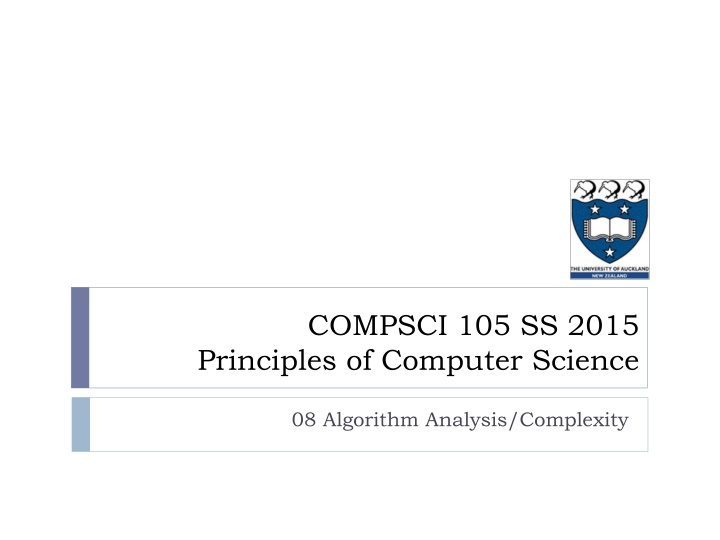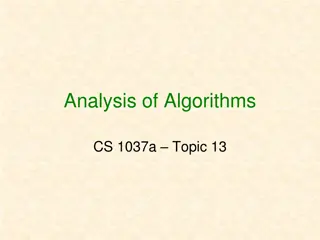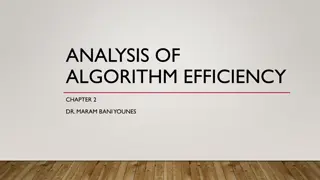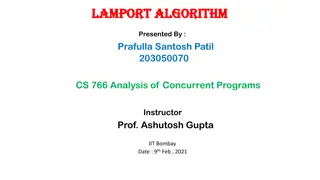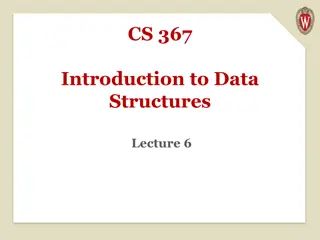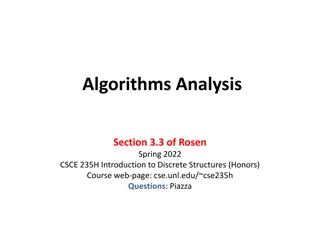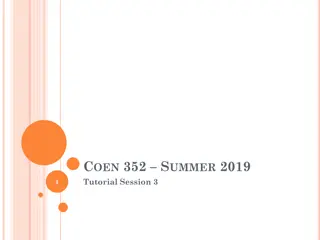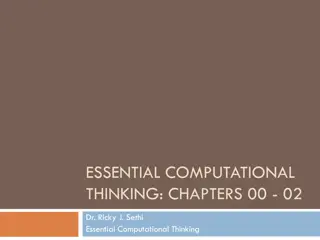Introduction to Algorithm Analysis and Complexity in Computer Science
Algorithm analysis is crucial in determining the efficiency of programs by analyzing resource usage such as time and space. This involves comparing programs, understanding data structures, and evaluating algorithm performance. Efficiency is key as program execution time depends on various factors beyond just algorithm efficiency.
Download Presentation

Please find below an Image/Link to download the presentation.
The content on the website is provided AS IS for your information and personal use only. It may not be sold, licensed, or shared on other websites without obtaining consent from the author.If you encounter any issues during the download, it is possible that the publisher has removed the file from their server.
You are allowed to download the files provided on this website for personal or commercial use, subject to the condition that they are used lawfully. All files are the property of their respective owners.
The content on the website is provided AS IS for your information and personal use only. It may not be sold, licensed, or shared on other websites without obtaining consent from the author.
E N D
Presentation Transcript
COMPSCI 105 SS 2015 Principles of Computer Science 08 Algorithm Analysis/Complexity
Agenda & Reading Agenda: Introduction Counting Operations Big-O Definition Properties of Big-O Calculating Big-O Growth Rate Examples Big-O Performance of Python Lists Big-O Performance of Python Dictionaries Reading: Problem Solving with Algorithms and Data Structures Chapter 2 2 COMPSCI105 Lecture 07-08
1 Introduction What Is Algorithm Analysis? How to compare programs with one another? When two programs solve the same problem but look different, is one program better than the other? What criteria are we using to compare them? Readability? Efficient? Why do we need algorithm analysis/complexity ? Writing a working program is not good enough The program may be inefficient! If the program is run on a large data set, then the running time becomes an issue 3 COMPSCI105 Lecture 07-08
1 Introduction Data Structures & Algorithm Data Structures: A systematic way of organizing and accessing data. No single data structure works well for ALL purposes. Algorithm An algorithm is a step-by-step procedure for solving a problem in a finite amount of time. Program is an algorithm that has been encoded into some programming language. Program = data structures + algorithms Input Algorithm Output 4 COMPSCI105 Lecture 07-08
1 Introduction Algorithm Analysis/Complexity When we analyze the performance of an algorithm, we are interested in how much of a given resource the algorithm uses to solve a problem. The most common resources are time (how many steps it takes to solve a problem) and space (how much memory it takes). We are going to be mainly interested in howlong our programs take to run, as time is generally a more precious resource than space. 5 COMPSCI105 Lecture 07-08
1 Introduction Efficiency of Algorithms For example, the following graphs show the execution time, in milliseconds, against sample size, n of a given problem in different computers More powerful computer The actual running time of a program depends not only on the efficiency of the algorithm, but on many other variables: Processor speed & type Operating system etc 6 COMPSCI105 Lecture 07-08
1 Introduction Running-time of Algorithms In order to compare algorithm speeds experimentally All other variables must be kept constant, i.e. independent of specific implementations, independent of computers used, and, independent of the data on which the program runs Involved a lot of work (better to have some theoretical means of predicting algorithm speed) 7 COMPSCI105 Lecture 07-08
1 Introduction Example 1 Task: Complete the sum_of_n()function which calculates the sum of the first n natural numbers. Arguments: an integer Returns: the sum of the first n natural numbers Cases: sum_of_n(5) 15 sum_of_n(100000) 5000050000 8 COMPSCI105 Lecture 07-08
1 Introduction Algorithm 1 sum_of_n Set the_sum = 0 Add each value to the_sum using a for loop Return the_sum time_start = time.time() The timing calls embedded before and after the summation to calculate the time required for the calculation the_sum = 0 for i in range(1,n+1): the_sum = the_sum + I time_end = time.time() time_taken = time_end - time_start 9 COMPSCI105 Lecture 07-08
1 Introduction Algorithm 2 sum_of_n_2 Set the_sum = 0 Use the equation (n(n + 1))/2, to calculate the total Return the_sum time_start = time.clock() the_sum = 0 the_sum = (n * (n+1) ) / 2 time_end = time.clock() time_taken = time_end - time_start) 10 COMPSCI105 Lecture 07-08
1 Introduction Experimental Result Using 4 different values for n: [10000, 100000, 1000000, 10000000] n sum_of_n (for loop) 0.0033 0.0291 0.3045 2.7145 sum_of_n_2 (equation) 0.00000181 0.00000131 0.00000107 0.00000123 10000 100000 1000000 10000000 Time NO impacted by the number of integers being added. Time increase as we increase the value of n. Consuming Process! We shall count the number of basic operations of an algorithm, and generalise the count. 11 COMPSCI105 Lecture 07-08
1 Introduction Advantages of Learning Analysis Predict the running-time during the design phase The running time should be independent of the type of input The running time should be independent of the hardware and software environment Save your time and effort The algorithm does not need to be coded and debugged Help you to write more efficient code 12 COMPSCI105 Lecture 07-08
2 Counting Operations Basic Operations We need to estimate the running time as a function of problem size n. A primitive Operation takes a unit of time. The actual length of time will depend on external factors such as the hardware and software environment Each of these kinds of operation would take the same amount of time on a given hardware and software environment Assigning a value to a variable Calling a method. Performing an arithmetic operation. Comparing two numbers. Indexing a list element. Returning from a function 13 COMPSCI105 Lecture 07-08
2 Counting Operations Example 2A Example: Calculating a sum of first 10 elements in the list def count1(numbers): the_sum = 0 index = 0 while index < 10: the_sum = the_sum + numbers[index] index += 1 return the_sum 1 assignment -> 1 assignment -> 11 comparisons -> 10 plus/assignments -> 10 plus/assignments -> 1 return -> Total = 34 operations 14 COMPSCI105 Lecture 07-08
2 Counting Operations Example 2B Example: Calculating the sum of elements in the list. def count2(numbers): n = len(numbers) the_sum = 0 index = 0 while index < n: the_sum = the_sum + numbers[index] index += 1 return the_sum 1 assignment -> 1 assignment -> 1 assignment -> n +1 comparisons -> n plus/assignments -> n plus/assignments -> 1 return Total = 3n + 5 operations We need to measure an algorithm s time requirement as a function of the problem size, e.g. in the example above the problem size is the number of elements in the list. 15 COMPSCI105 Lecture 07-08
2 Counting Operations Problem size Performance is usually measured by the rate at which the running time increases as the problem size gets bigger, ie. we are interested in the relationship between the running time and the problem size. It is very important that we identify what the problem size is. For example, if we are analyzing an algorithm that processes a list, the problem size is the size of the list. In many cases, the problem size will be the value of a variable, where the running time of the program depends on how big that value is. 16 COMPSCI105 Lecture 07-08
2 Counting Operations Exercise 1 How many operations are required to do the following tasks? ? Adding an element to the end of a list a) Printing each element of a list containing n elements b) ? 17 COMPSCI105 Lecture 07-08
2 Counting Operations Example 3 Consider the following two algorithms: Algorithm A: Outer Loop: n operations Inner Loop: ? for i in range(0, n): for j in range(0, n, 5): print (i,j) 5operations 5 ) = (?2 Total = (? ? 5 ) operations Algorithm B: Outer Loop: n operations Inner Loop: 5 operations Total = n * 5 = 5*n operations for i in range(0, n): for j in range(0, 5): print (i,j) 18 COMPSCI105 Lecture 07-08
2 Counting Operations Growth Rate Function A or B? If n is 106 , Algorithm A s time requirement is (?2 5 ) = (1012 5 ) = 2 * 1011 Algorithm B s time requirement is 5*n = 5 * 106 What does the growth rate tell us about the running time of the program? A is faster when n is a small number 19 COMPSCI105 Lecture 07-08
2 Counting Operations Growth Rate Function A or B? For smaller values of n, the differences between algorithm A (n2/5) and algorithm B (5n) are not very big. But the differences are very evident for larger problem sizes such as for n > 1,000,000 2 * 1011 Vs 5 * 106 Bigger problem size, produces bigger differences Algorithm efficiency is a concern for large problem sizes 20 COMPSCI105 Lecture 07-08
3 Big-O Big-O Definition Let ?(?) and ?(?) be functions that map nonnegative integers to real numbers. We say that ?(?) is O(?(?) ) if there is a real constant, c, where c > 0 and an integer constant n0, where n0 1 such that ?(?) c ?(?) for every integer n n0. ?(?) describe the actual time of the program ?(?) is a much simpler function than ?(?) With assumptions and approximations, we can use ?(?) to describe the complexity i.e. O(?(?)) Big-O Notation is a mathematical formula that best describes an algorithm s performance 21 COMPSCI105 Lecture 07-08
3 Big-O Big-O Notation We use Big-O notation (capital letter O) to specify the order of complexity of an algorithm e.g., O(n2 ) , O(n3 ) , O(n ). If a problem of size n requires time that is directly proportional to n, the problem is O(n) that is, order n. If the time requirement is directly proportional to n2, the problem is O(n2), etc. 22 COMPSCI105 Lecture 07-08
3 Big-O Big-Oh Notation (Formal Definition) Given functions ?(?) and ? ? , we say that ?(?) is O(?(?) ) if there are positive constants, c and n0, such that ?(?) c ?(?) for every integer n n0. 10,000 3n Example: 2n + 10 is O(n) 2n + 10 cn (c 2) n 10 n 10/(c 2) Pick c = 3 and n0 = 10 2n+10 1,000 n 100 10 1 1 10 100 1,000 n 23 COMPSCI105 Lecture 07-08
3 Big-O Big-O Examples ?(?) c ?(?) for every integer n >= n0. Suppose an algorithm requires 7n-2 operations to solve a problem of size n O(n) 7n-2 7 * n for all n0 1 i.e. c = 7, n0 = 1 n2 - 3 * n + 10 operations to solve a problem of size n O(n2) n2 -3 * n + 10 < 3 * n2 for all n0 2 i.e. c = 3, n0 = 2 3n3 + 20n2 + 5 operations to solve a problem of size n 3n3 + 20n2 + 5 < 4 * n3 for all n0 21 i.e. c = 4, n0 = 21 O(n3) 24 COMPSCI105 Lecture 07-08
4 Properties of Big-O Properties of Big-O There are three properties of Big-O Ignore low order terms in the function (smaller terms) O(f(n)) + O(g(n)) = O(max of f(n) and g(n)) Ignore any constants in the high-order term of the function C* O(f(n)) = O(f(n)) Combine growth-rate functions O(f(n)) * O(g(n)) = O(f(n)*g(n)) O(f(n)) + O(g(n)) = O(f(n)+g(n)) 25 COMPSCI105 Lecture 07-08
4 Properties of Big-O Ignore low order terms Consider the function: For small values of n the last term, 1000, dominates. When n is around 10, the terms 100n + 1000 dominate. When n is around 100, the terms n2 and 100n dominate. When n gets much larger than 100, the n2 dominates all others. So it would be safe to say that this function is O(n2) for values of n > 100 Consider another function: f(n) = n2 + 100n + log10n + 1000 f(n) = n3 + n2 + n + 5000 Big-O is O(n3) And consider another function: f(n) = n + n2 + 5000 Big-O is O(n2) 26 COMPSCI105 Lecture 07-08
4 Properties of Big-O Ignore any Constant Multiplications Consider the function: f(n) = 254 * n2 + n Big-O is O(n2) Consider another function: f(n) = n / 30 Big-O is O(n) And consider another function: f(n) = 3n + 1000 Big-O is O(n) 27 COMPSCI105 Lecture 07-08
4 Properties of Big-O Combine growth-rate functions Consider the function: f(n) = n * log n Big-O is O(n log n) Consider another function: f(n) = n2 * n Big-O is O(n3) 28 COMPSCI105 Lecture 07-08
4 Properties of Big-O Exercise 2 What is the Big-O performance of the following growth functions? T(n) = n + log(n) ? ? T(n) = n4 + n*log(n) + 300n3 ? T(n) = 300n + 60 * n * log(n) + 342 29 COMPSCI105 Lecture 07-08
4 Properties of Big-O Best, average & worst-case complexity In some cases, it may need to consider the best, worst and/or average performance of an algorithm For example, if we are required to sort a list of numbers an ascending order Worst-case: if it is in reverse order Best-case: if it is already in order Average-case Determine the average amount of time that an algorithm requires to solve problems of size n More difficult to perform the analysis Difficult to determine the relative probabilities of encountering various problems of a given size Difficult to determine the distribution of various data values 30 COMPSCI105 Lecture 07-08
5 Calculating Big-O Calculating Big-O Rules for finding out the time complexity of a piece of code Straight-line code Loops Nested Loops Consecutive statements If-then-else statements Logarithmic complexity 31 COMPSCI105 Lecture 07-08
5 Calculating Big-O Rules Rule 1: Straight-line code Big-O = Constant time O(1) Does not vary with the size of the input Example: Assigning a value to a variable Performing an arithmetic operation. Indexing a list element. x = a + b i = y[2] Rule 2: Loops The running time of the statements inside the loop (including tests) times the number of iterations Example: Constant time * n = c * n = O(n) Executed n times for i in range(n): print(i) Constant time 32 COMPSCI105 Lecture 07-08
5 Calculating Big-O Rules (con t) Rule 3: Nested Loop Analyze inside out. Total running time is the product of the sizes of all the loops. Example: constant * (inner loop: n)*(outer loop: n) Total time = c * n * n = c*n2 = O(n2) Outer loop: Executed n times for i in range(n): for j in range(n): k = i + j Inner loop: Executed n times Rule 4: Consecutive statements Add the time complexities of each statement Example: Constant time + n times * constant time c0 + c1n Big-O = O(f(n) + g(n)) = O( max ( f(n) + g(n))) = O(n) Constant time x = x + 1 for i in range(n): m = m + 2; Executed n times 33 COMPSCI105 Lecture 07-08
5 Calculating Big-O Rules (con t) Rule 5: if-else statement Worst-case running time: the test, plus either the if part or the else part (whichever is the larger). Example: c0 + Max(c1, (n * (c2 + c3))) Total time = c0 * n(c2 + c3) = O(n) Assumption: The condition can be evaluated in constant time. If it is not, we need to add the time to evaluate the expression. True case: Constant c1 Test: if len(a) != len(b): return False else: for index in range(len(a)): if a[index] != b[index]: return False Constant time c0 False case: Executed n times Another if: constant c2 + constant c3 34 COMPSCI105 Lecture 07-08
5 Calculating Big-O Rules (con t) Rule 6: Logarithmic An algorithm is O(log n) if it takes a constant time to cut the problem size by a fraction (usually by ) Example: Finding a word in a dictionary of n pages Look at the centre point in the dictionary Is word to left or right of centre? Repeat process with left or right part of dictionary until the word is found Example: size = n while size > 0: // O(1) stuff size = size / 2 Size: n, n/2, n/4, n/8, n/16, . . . 2, 1 If n = 2K, it would be approximately k steps. The loop will execute log k in the worst case (log2n = k). Big-O = O(log n) Note: we don t need to indicate the base. The logarithms to different bases differ only by a constant factor. 35 COMPSCI105 Lecture 07-08
6 Growth Rate Examples Hypothetical Running Time The running time on a hypothetical computer that computes 106 operations per second for varies problem sizes Notation n 10 102 103 104 105 106 O(1) Constant 1 sec 1 sec 1 sec 1 sec 1 sec 1 sec O(log(n)) Logarithmic 3 sec 7 sec 10 sec 13 sec 17 sec 20 sec O(n) Linear 10 sec 100 sec 1 msec 10 msec 100 msec 1 sec O(nlog(n)) N log N 33 sec 664 sec 10 msec 13.3 msec 1.6 sec 20 sec O(n2) Quadratic 100 sec 10 msec 1 sec 1.7 min 16.7 min 11.6 days O(n3) Cubic 1 msec 1 sec 16.7 min 11.6 days 31.7 years 31709 years O(2n) Exponential 10 msec 3e17 years 36 COMPSCI105 Lecture 07-08
6 Growth Rate Examples Comparison of Growth Rate A comparison of growth-rate functions in graphical form 37 COMPSCI105 Lecture 07-08
6 Growth Rate Examples Constant Growth Rate - O(1) Time requirement is constant and, therefore, independent of the problem s size n. def rate1(n): s = "SWEAR" for i in range(25): print("I must not ", s) n O(1) 101 1 102 1 103 1 104 1 105 1 106 1 38 COMPSCI105 Lecture 07-08
6 Growth Rate Examples Logarithmic Growth Rate - O(log n) Increase slowly as the problem size increases If you square the problem size, you only double its time requirement The base of the log does not affect a log growth rate, so you can omit it. def rate2(n): s = "YELL" i = 1 while i < n: print("I must not ", s) i = i * 2 n O(log2 n) 101 3 102 6 103 9 104 13 105 16 106 19 39 COMPSCI105 Lecture 07-08
6 Growth Rate Examples Linear Growth Rate - O(n) The time increases directly with the sizes of the problem. If you square the problem size, you also square its time requirement def rate3(n): s = "FIGHT" for i in range(n): print("I must not ", s) n O(n) 101 10 102 102 103 103 104 104 105 105 106 106 40 COMPSCI105 Lecture 07-08
6 Growth Rate Examples n* log n Growth Rate - O(n log(n)) The time requirement increases more rapidly than a linear algorithm. Such algorithms usually divide a problem into smaller problem that are each solved separately. def rate4(n): s = "HIT" for i in range(n): j = n while j > 0: print("I must not ", s) j = j // 2 n O(nlog(n)) 101 30 102 664 103 9965 104 105 105 106 106 107 41 COMPSCI105 Lecture 07-08
6 Growth Rate Examples Quadratic Growth Rate - O(n2) The time requirement increases rapidly with the size of the problem. Algorithms that use two nested loops are often quadratic. def rate5(n): s = "LIE" for i in range(n): for j in range(n): print("I must not ", s) n O(n2) 101 102 102 104 103 106 104 108 105 1010 106 1012 42 COMPSCI105 Lecture 07-08
6 Growth Rate Examples Cubic Growth Rate - O(n3) The time requirement increases more rapidly with the size of the problem than the time requirement for a quadratic algorithm Algorithms that use three nested loops are often quadratic and are practical only for small problems. def rate6(n): s = "SULK" for i in range(n): for j in range(n): for k in range(n): print("I must not ", s) n O(n3) 101 103 102 106 103 109 104 1012 105 1015 106 1018 43 COMPSCI105 Lecture 07-08
6 Growth Rate Examples Exponential Growth Rate - O(2n) As the size of a problem increases, the time requirement usually increases too rapidly to be practical. def rate7(n): s = "POKE OUT MY TONGUE" for i in range(2 ** n): print("I must not ", s) n O(2n) 101 103 102 1030 103 10301 104 103010 105 1030103 106 10301030 44 COMPSCI105 Lecture 07-08
Exercise 3 What is the Big-O of the following statements? for i in range(n): for j in range(10): print (i,j) Executed n times Executed 10 times Constant time ? Running time = n * 10 * 1 =10n, Big-O = What is the Big-O of the following statements? Executed n times for i in range(n): for j in range(n): print(i,j) for k in range(n): print(k) Executed n times Executed n times The first set of nested loops is O(n2) and the second loop is O(n). This is O(max(n2,n)) Big-O = ? 45 COMPSCI105 Lecture 07-08
Exercise 3 What is the Big-O of the following statements? for i in range(n): for j in range(i+1, n): print(i,j) When i is 0, the inner loop executes (n-1) times. When i is 1, the inner loop executes n-2 times. When i is n-2, the inner loop execute once. The number of times the inner loop statements execute: (n-1) + (n-2) ... + 2 + 1 Running time = n*(n-1)/2, Big-O = ? 46 COMPSCI105 Lecture 07-08
7 Performance of Python Lists Performance of Python Data Structures We have a general idea of Big-O notation and the differences between the different functions, Now, we will look at the Big-O performance for the operations on Python lists and dictionaries. It is important to understand the efficiency of these Python data structures In later chapters we will see some possible implementations of both lists and dictionaries and how the performance depends on the implementation. 47 COMPSCI105 Lecture 07-08
7 Performance of Python Lists Review Python lists are ordered sequences of items. Specific values in the sequence can be referenced using subscripts. Python lists are: dynamic. They can grow and shrink on demand. heterogeneous, a single list can hold arbitrary data types. mutable sequences of arbitrary objects. 48 COMPSCI105 Lecture 07-08
7 Performance of Python Lists List Operations Using operators: my_list = [1,2,3,4] print (2 in my_list) True [0, 0, 0, 0, 0, 0, 0, 0, 0, 0, 0, 0, 0, 0, 0, 0, 0, 0, 0, 0] zeroes = [0] * 20 print (zeroes) 49 COMPSCI105 Lecture 07-08
7 Performance of Python Lists List Operations Using Methods: 50 COMPSCI105 Lecture 07-08
